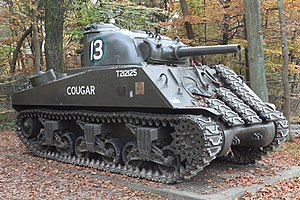M4 Medium Tank
| Medium Tank M4 | |
|---|---|

An M4 (105) Sherman tank with spare track-links welded on its front for additional armour protection, preserved at the Langenberg Liberation Memorial in Ede, Netherlands
|
|
| Type | Medium tank |
| Place of origin | United States |
| Service history | |
| In service | 1942–1955 (U.S.) 1945–present (Other countries) |
| Used by | United States, and many others (see Foreign variants and use) |
| Wars | World War II, Chinese Civil War, Indonesian National Revolution, Greek Civil War, 1948 Arab–Israeli War, Korean War, Revolución Libertadora, Suez Crisis, Indo-Pakistani War of 1965, Six-Day War, Indo-Pakistani War of 1971, Yom Kippur War, Iran–Iraq War, 1958 Lebanon crisis, Lebanese Civil War, Cuban Revolution, Nicaraguan Revolution |
| Production history | |
| Designer | U.S. Army Ordnance Department |
| Designed | 1940 |
| Manufacturer | American Locomotive Co., Baldwin Locomotive Works, Detroit Tank Arsenal, Federal Machine and Welder Co., Fisher Tank Arsenal, Ford Motor Company, Lima Locomotive Works, Pacific Car and Foundry Company, Pressed Steel Car Company, Pullman-Standard Car Company |
| Unit cost | $44,556-$64,455 in 1945 dollars, depending upon variant |
| Produced | September 1941 (prototype) February 1942–July 1945 |
| Number built | 49,234 |
| Variants | See U.S. variants and foreign variants |
| Specifications | |
| Weight | 66,800-84,000 lb (30.3-38.1 metric tons) depending upon variant |
| Length | 19 ft 2 in-20 ft 7 in (5.84-6.27 m) depending upon variant |
| Width | 8 ft 7 in-9 ft 10 in (2.62-2.99 m) depending upon variant |
| Height | 9 ft 0 in-9 ft 9 in (2.74-2.97 m) depending upon variant |
| Crew | 5 (commander, gunner, loader, driver, co-driver) |
|
|
|
| Armor | 12.7 mm (0.5 in) minimum Up to a maximum of 177.8 mm (7.0 in) depending upon variant |
|
Main
armament |
75 mm gun M3 (90-104 rounds) or 76 mm gun M1A1, M1A1C, or M1A2 (71 rounds) or 105 mm howitzer M4 (66 rounds) |
|
Secondary
armament |
.50 caliber Browning M2HB machine gun (300-600 rounds), 2×.30 caliber Browning M1919A4 machine guns (6,250-6,750 rounds) |
| Engine |
M4 and M4A1 model: Continental R975-C1 or -C4 9 cylinder radial gasoline engine, |
| Transmission | Spicer manual synchromesh transmission, 5 forward and 1 reverse gears |
| Suspension | Vertical volute spring suspension (VVSS) or horizontal volute spring suspension (HVSS) |
| Fuel capacity | 138-175 US gallons (522-662 litres) depending upon variant |
|
Operational
range |
100-150 miles (161-241 km) on road depending upon variant |
| Speed | 22 to 30 mph (35 to 48 km/h) |
M4 and M4A1 model: Continental R975-C1 or -C4 9 cylinder radial gasoline engine,
350 or 400 hp (261 or 298 kW) at 2,400 rpm
M4A2 model: General Motors 6046 twin diesel engine; 375 hp (280 kW) at 2,100 rpm
M4A3 model: Ford GAA V8 gasoline engine; 450 hp (336 kW) at 2,600 rpm
M4A4 model: Chrysler A57 multibank gasoline engine; 370 hp (276 kW) at 2,400 rpm
The M4 Sherman, officially Medium Tank, M4, was the most numerous battle tank used by the United States and some of the other Western Allies in World War II. The M4 Sherman proved to be reliable, relatively cheap to produce and available in great numbers. Thousands were distributed through the Lend-Lease program to the British Commonwealth and Soviet Union. The tank was named by the British for the American Civil War General William Tecumseh Sherman.
The M4 Sherman evolved from the interim M3 Medium Tank, which had its main armament in a side sponson mount. The M4 retained much of the previous mechanical design, but put the main 75 mm gun in a fully traversing turret. One feature, a one-axis gyrostabilizer, was not precise enough to allow firing when moving but did help keep the reticle on target, so that when the tank did stop to fire, the gun would be aimed in roughly the right direction. The designers stressed mechanical reliability, ease of production and maintenance, durability, standardization of parts and ammunition in a limited number of variants, and moderate size and weight. These factors, combined with the Sherman's then-superior armor and armament, outclassed German light and medium tanks of 1939–42. The M4 went on to be produced in large numbers. It spearheaded many offensives by the Western Allies after 1942.
...
Wikipedia
